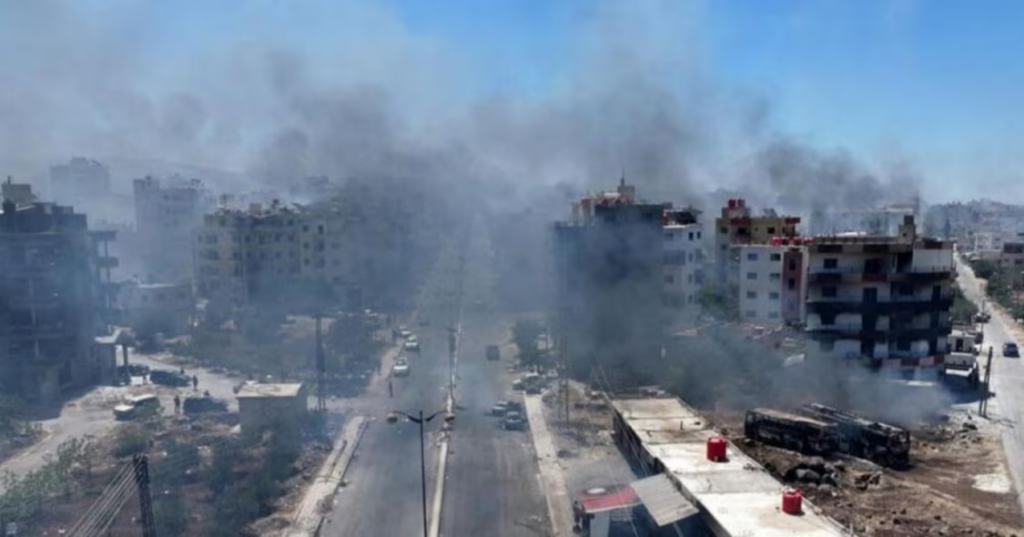
The demonstrations organized by the Druze community in Suwayda, demanding the right to self-determination and declaring independence from Syria, were neither a fleeting episode nor a simple reaction to the brutal crackdown launched by the transitional authority in Damascus last July. That assault on the Mount of Druze claimed thousands of deaths and grave human rights violations, leaving enduring scars on the community.
Since Hayat Tahrir Al-Sham (HTS – formerly Jabhat Al-Nusra, Al-Qaeda’s branch in the Levant) seized control of Damascus in December 2024, following the flight of dictator Bashar Al-Assad, Syria’s minority communities have lived under profound anxiety. Their fear derives not only from HTS’s terrorist past and that of its leader, Abu Mohammed Al-Joulani – who now rebrands himself as transitional president Ahmed Al-Shara – but also from the systematic abuses the authority has continued to perpetrate over the past nine months.
Syria Is A Patchwork Of Diverse Communities Bound Together Only By Fragile Ties
Prior to the brutal campaign against the Druze people in Suwayda, the coastal region witnessed a massacre of the Alawite community in March, leaving thousands dead in what the UN Independent International Commission of Inquiry on Syria classified as war crimes. In Damascus, a suicide attack targeted a Christian church, further deepening the sense of vulnerability among minority groups. Meanwhile, HTS’s media outlets and affiliated influencers have persistently incite hatred, openly calling for the extermination of the Kurds.
Despite the attempts by Turkey, Qatar, and Saudi Arabia to promote HTS and whitewash its actions, the scale of violations has proven impossible to conceal. Over the past nine months alone, HTS’s crimes and the chaos engulfing Syria have claimed more than 10,000 lives – twice the number of casualties in the first year of the Syrian war in 2011. This trajectory raises serious concerns about how the situation in Syria could further deteriorate if Julani and HTS remain in power in Damascus.
In fact, since its establishment a century ago by France and Britain under the Sykes-Picot and San Remo agreements, Syria has remained a patchwork of diverse communities bound together only by fragile ties.
For the Kurds of northern and northeastern Syria, whose lands have historically been regarded as part of Kurdistan, incorporation into the newly created Syrian state meant partition and annexation. Despite being the second-largest ethnic group with about 20% in Syria, the Kurds have been systematically deprived of their political and cultural rights.
Hundreds of thousands of Kurds were stripped of citizenship, while their regions have been subjected to deliberate demographic engineering. This took the form of Arabization under successive Arab nationalist regimes – beginning with Gamal Abdel Nasser in 1958 and later under the Baath Party – as well as Turkification following Turkey’s cross-border invasions and occupations of Shahba in 2016, Afrin in 2018, Serêkanîye (Ras Al-Ain) and Girêsipî (Tal Abyad) in 2019.
The Druze, a distinct religious minority numbering nearly one million, saw their anxieties deepen with HTS’s rise to power in Damascus. Were it not for the intervention of the Israel Defense Force (IDF), at the request of Druze leaders in Israel, the Druze of Suwayda might have faced large-scale ethnic cleansing. Their public raising of the Israeli flag in gratitude, coupled with explicit calls for self-determination, reflects the depth of their existential fears.
As for the Alawites, who inhabit the coastal region in western Syria and constitute roughly 15% of the population, were politically represented for decades by Hafez Al-Assad and later by his son Bashar. Yet, their religious distinctiveness was deliberately obscured to consolidate Assad’s rule, portraying them either as part of the broader Sunni Arab Muslim majority or as a Shiite offshoot.
Nevertheless, this did not shield them from Sunni Arab reprisals following Assad’s fall. Many Alawites currently recognize that their survival hinges on preserving their cultural and religious identity and the pursuit of autonomous governance structures.
Even the Sunni Arabs, often labeled the “majority,” are far from a homogeneous bloc. Although they make up about 40% of the population, they are divided into three main categories:
Tribal and Bedouin communities, mainly in the desert and eastern regions (and to a lesser extent in the south and central areas).
Urban populations in Damascus, Aleppo, and Hama, many of whom have been Arabized over time but trace their ancestry to Kurdish, Syriac, Turkmen, and Byzantine roots, they organize around extended families rather than tribes and maintain customs distinct from those of the Bedouins.
In addition, there are the rural agricultural communities.The interests, affiliations, and orientations of these groups differ significantly and would become even more apparent if they were allowed the freedom to express them. This highlights that Syria, as an artificial state, has failed for over a century to create a unifying national identity that encompasses its diverse ethnic, religious, and cultural communities.
During the French Mandate (1920–1946), the Kurdish, Druze and Alawites sought varying degrees of self-rule but were forcibly integrated into a centralized Syrian state. This outcome reflected France’s strategic calculations with Turkey, which at the same time was violently repressing Kurdish nationalist aspirations, including the Dersim Genocide (1937–1939), while France ceded the multi-ethnic Sanjak of Alexandretta (Hatay) to Turkey.
Subsequently, centralized rule was enforced under the banner of Arab nationalism, systematically suppressing and marginalizing peripheral regions and diverse communities for decades. Slogans promoting Arab unity, hostility toward Israel, and the instrumentalization of Islamist movements such as Hamas and Hizbullah were employed as political tools.
This forced unification ultimately erupted into civil war in 2011, creating fertile ground for terrorist organizations to exploit both the ensuing chaos and the deep-rooted divisions among Syria’s diverse communities – divisions long contained within artificial borders.
A Federal Or Confederal Solution In Syria
HTS itself emerged as a byproduct of both the Baathist regime and the civil war. Today, it replicates the same authoritarian patterns, imposing a singular nationalist identity now compounded by an Islamist ideology. To prevent history from tragically repeating itself and to avert a return to chaos and the spread of extremism, Syria requires a governance system anchored in federalism – or even confederalism.
A federal or confederal solution in Syria would recognize the identities and aspirations of its diverse communities, empower these communities rather than subjugate them, address minorities’ fears of political and economic marginalization, and provide them with meaningful self-governance. Such an approach would underscore inclusive participation and representation, particularly in the post-conflict phase.
The implementation of this approach requires a set of concrete arrangements, anchored in binding international guarantees and jointly overseen by UN, US and EU-led mechanisms, designed to deter violations, enforce accountability, and foster durable stability. These arrangements can be outlined as follows:
A new constitution, that must unambiguously define the powers of the federal government and regional entities – or, in a confederal model, the authority of each unit. It should contain explicit provisions recognizing and protecting the identity and rights of all communities.
Multi-layered security guarantees, that should allow each region to maintain its own security and defense forces within a nationally coordinated and disciplined framework. Civilian oversight and binding human rights safeguards are essential to prevent abuses while ensuring genuine protection against violence and extremism.
Equitable and transparent reconstruction programs, that must be anchored in a fair revenue-sharing system, that ensures all regions receive a just allocation of resources. Strong oversight and accountability mechanisms are necessary to prevent misappropriation, political exploitation, or the diversion of funds to terrorism.
Transitional justice and reconciliation mechanisms, that should include reparations and accountability for perpetrators of major crimes committed by all parties. Locally rooted reconciliation committees, led by respected figures with both domestic and international credibility, should play a central role in ensuring justice and promoting social healing.
A bicameral parliament, that should provide robust representational guarantees for all communities in both legislative and judicial institutions It must be supported by constitutional dispute-resolution mechanisms that safeguard not only individual rights but also collective community rights.A More Durable Response To Syria’s Cycles Of Violence
While federalism presents the most viable framework to avert Syria’s relapse into civil war, chronic instability, and renewed terrorism – threats that endanger not only Syria but also regional and international security – it nonetheless faces significant obstacles. These include the refusal of certain communities to embrace coexistence, the entrenched intransigence of HTS regarding genuine political transition and recognition of regional self-governance, and the persistent malign interference of regional actors, particularly Turkey.
In this light, the alternative to federalism that can realistically materialize is not a regression to coerced centralization and forced unification, but rather the establishment of a confederation – or even the emergence of independent states – that coexist peacefully within a newly defined geopolitical landscape. Such a pathway offers a more durable response to Syria’s cycles of violence, denial, and protracted conflict, anchoring stability in the regions through decentralized governance and practical power-sharing.
